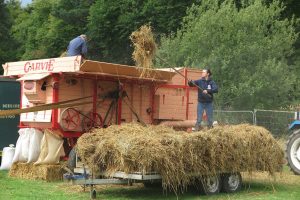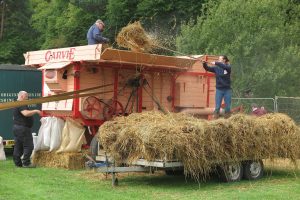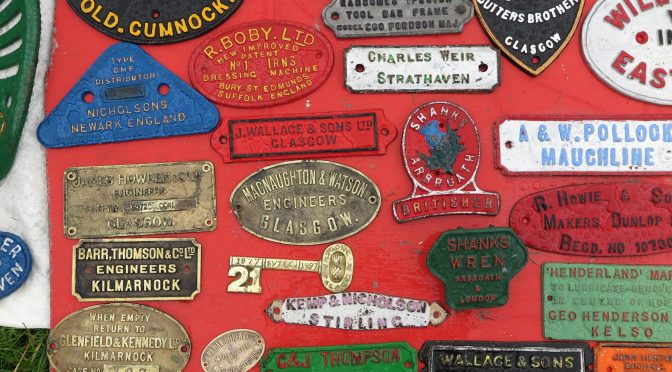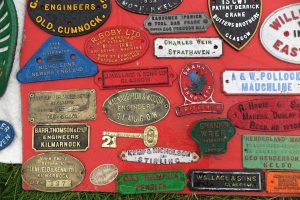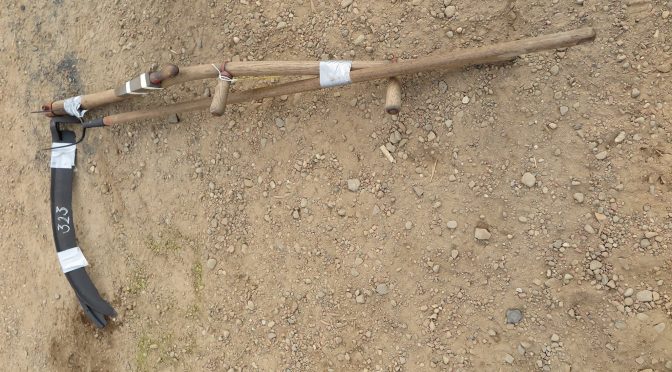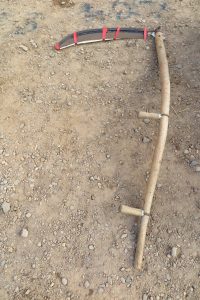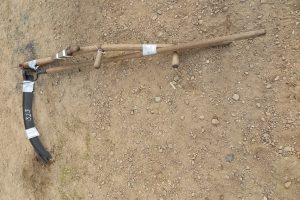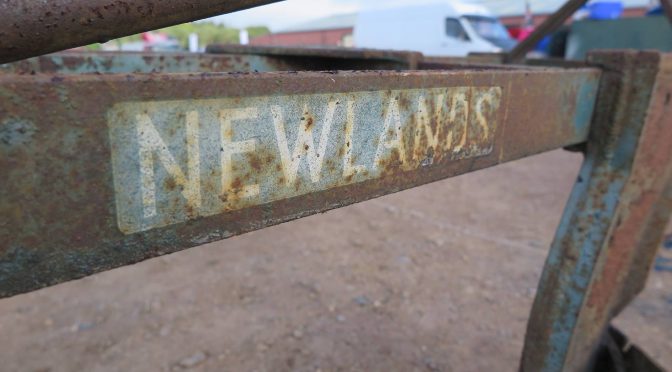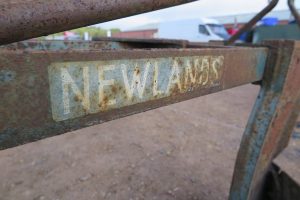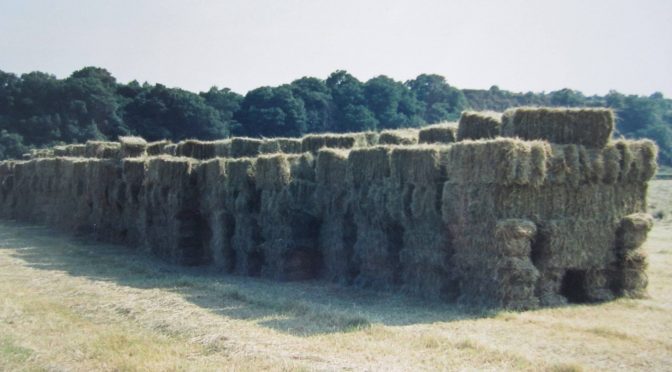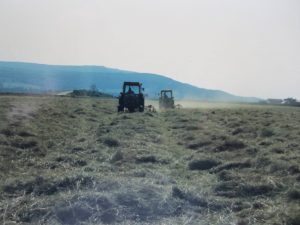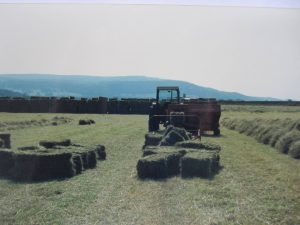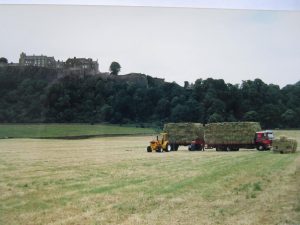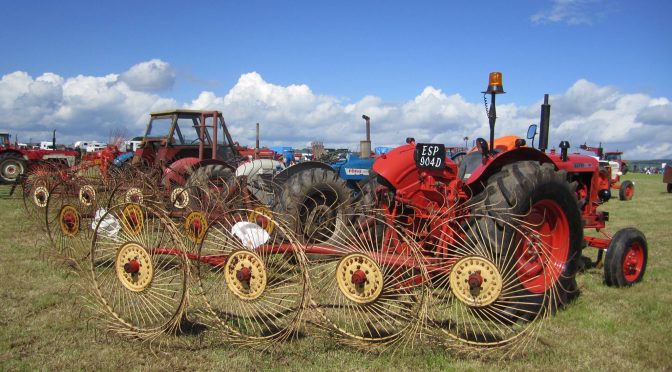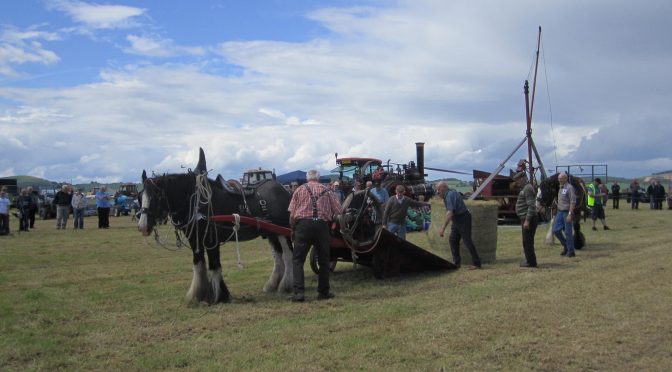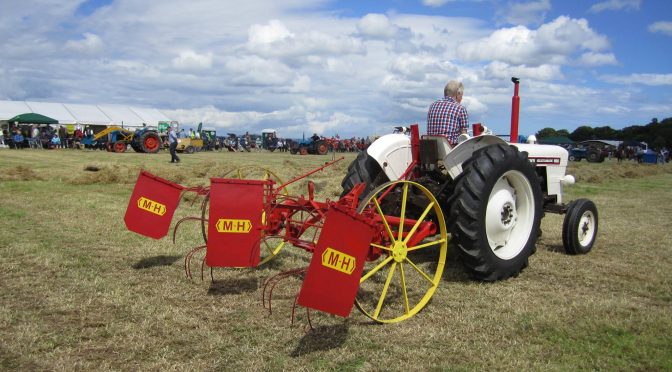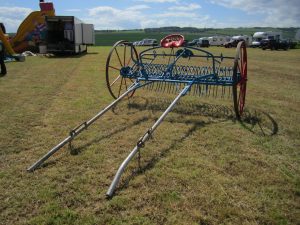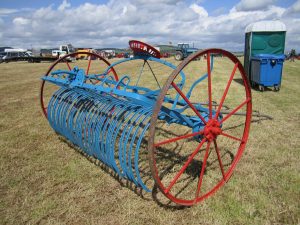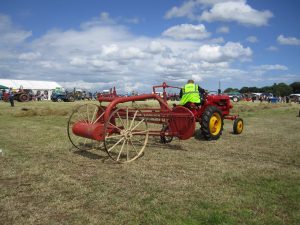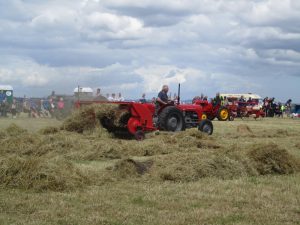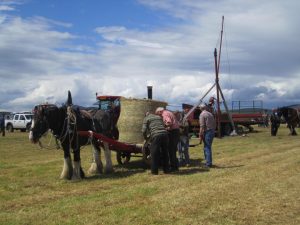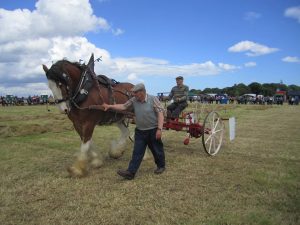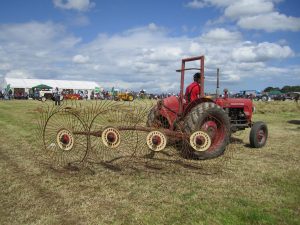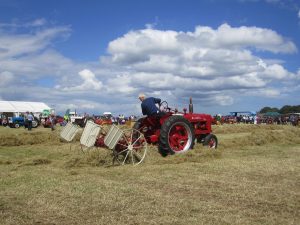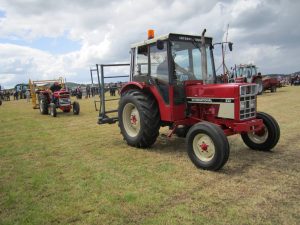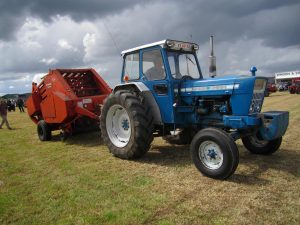How was haymaking undertaken in the olden days before all the mechanisation to make it easier to handle the crop?
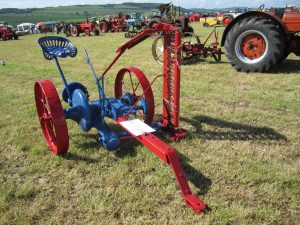 The Board of Agriculture’s county agricultural surveys provide some detailed account on agricultural processes as well as agricultural implements and machines. George Robertson, the surveyor for Midlothian, provides the following detailed account of haymaking for that county in 1795. It is worth quoting at length:
The Board of Agriculture’s county agricultural surveys provide some detailed account on agricultural processes as well as agricultural implements and machines. George Robertson, the surveyor for Midlothian, provides the following detailed account of haymaking for that county in 1795. It is worth quoting at length:
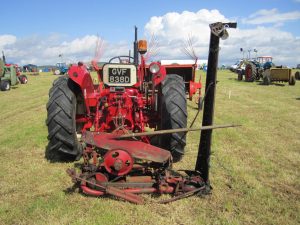 “Haymaking is performed here on the simple principle of giving it no more work than just suffices to win it, in order to preserve, as much as possible, the natural juices and flavour. The process differs, as the hay is either from seeds, or natural, according to the circumstances of these different cases.
“Haymaking is performed here on the simple principle of giving it no more work than just suffices to win it, in order to preserve, as much as possible, the natural juices and flavour. The process differs, as the hay is either from seeds, or natural, according to the circumstances of these different cases.
When hay from seeds, such as clover and rye grass, is cut down, there are two things respecting it to be remarked: 1. The swath is laid in pretty regular order, in form somewhat like to the blade of a razor, in which the ears incline to the edge, while the bottoms are piled up one above another in the opposite direction at the back. 2. The stalks, individually, are firm and straight, and like to reeds; naturally unsusceptible of moisture, but very readily admitting a 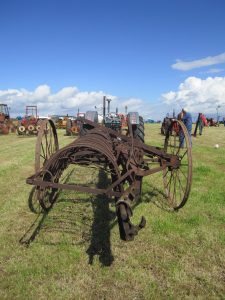 passage through them to the air, or the wind, as it blows over the field. In consequence of these two circumstances, hay, in this situation, is not difficult to to be win or made; for in dry weather, the air readily penetrates through it, and dries it quickly; and in wet weather, it is not apt to imbibe the rain, but rather sheds it off along its upper tire of stalks, and of course can stand a considerable deal of rain without receiving much damage, ad very readily becomes again dry on thereturn of fair weather; a fact well confirmed by experience; while, at the same time, its aromatick flavour, as well as natural colour, is very little exhausted or altered, as there is but a small proportion of its bulk exposed to the weather, the greater part remaining sheltered as under a shade, and dries by degrees, But should the haymakers, in the view of accelerating the process, turn it in the swath, the
passage through them to the air, or the wind, as it blows over the field. In consequence of these two circumstances, hay, in this situation, is not difficult to to be win or made; for in dry weather, the air readily penetrates through it, and dries it quickly; and in wet weather, it is not apt to imbibe the rain, but rather sheds it off along its upper tire of stalks, and of course can stand a considerable deal of rain without receiving much damage, ad very readily becomes again dry on thereturn of fair weather; a fact well confirmed by experience; while, at the same time, its aromatick flavour, as well as natural colour, is very little exhausted or altered, as there is but a small proportion of its bulk exposed to the weather, the greater part remaining sheltered as under a shade, and dries by degrees, But should the haymakers, in the view of accelerating the process, turn it in the swath, the 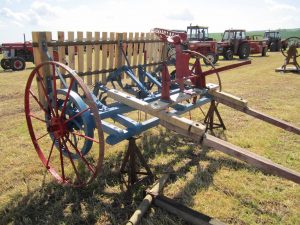 following circumstances will occur: 1. The swath, instead of presenting a regular inclined surface, naturally adapted to lea the rain off as it falls, will lie expanded, loose, and irregular; well adapted indeed to receive the influence of the winds, or of the rays of the sun in dry weather, but equally ready to catch rain in case of a shower. 2. The hay itself will have become so much bruised, or softened, in the operation, as to retain, and even imbibe, that moisture which in the former case it would have repelled or shed off. The consequence must be, (as it is known to be in fact), that hay, in this situation, if once it gets wet, is much more difficult to be got dry again, than if it had not been turned at all.
following circumstances will occur: 1. The swath, instead of presenting a regular inclined surface, naturally adapted to lea the rain off as it falls, will lie expanded, loose, and irregular; well adapted indeed to receive the influence of the winds, or of the rays of the sun in dry weather, but equally ready to catch rain in case of a shower. 2. The hay itself will have become so much bruised, or softened, in the operation, as to retain, and even imbibe, that moisture which in the former case it would have repelled or shed off. The consequence must be, (as it is known to be in fact), that hay, in this situation, if once it gets wet, is much more difficult to be got dry again, than if it had not been turned at all.
 There are, however, cases which frequently occur, in which it is proper to turn hay. This, if it has received rain, or has been protracted in the making, by a long continuance of damp weather, it must be turned in the swath at all hazards; and in most cases it will be proper to turn it in the forenoon of the same day in which it is meant to be put into large ricks in the afternoon; but in general, the process cannot be greatly advanced by that operation in good weather; and as it really retards it if followed y wet, the best way is it to let it alone till it is finally to be made, which in dry weather will be in about three days after it is cut, when it may be put into ricks of from 40 to 80 stone weight, where it may remain ten or twelve days longer, by which time it will be fit to be put into sows, or stacks, of any dimension. There is, however, one fact to be admitted, that in this mode of hay making the upper side of the swath, (exposed perhaps
There are, however, cases which frequently occur, in which it is proper to turn hay. This, if it has received rain, or has been protracted in the making, by a long continuance of damp weather, it must be turned in the swath at all hazards; and in most cases it will be proper to turn it in the forenoon of the same day in which it is meant to be put into large ricks in the afternoon; but in general, the process cannot be greatly advanced by that operation in good weather; and as it really retards it if followed y wet, the best way is it to let it alone till it is finally to be made, which in dry weather will be in about three days after it is cut, when it may be put into ricks of from 40 to 80 stone weight, where it may remain ten or twelve days longer, by which time it will be fit to be put into sows, or stacks, of any dimension. There is, however, one fact to be admitted, that in this mode of hay making the upper side of the swath, (exposed perhaps 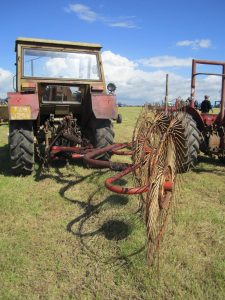 for three days together to the weather,) may be too much win, while the under side, for want of exposure, may be too little. There is, however, another fact, equally well ascertained, that by the time the hay is in the rick for 24 hours, the whole becomes one homogenous mass of the same degree of temperament; that which was too dry imbibing the superfluous moisture of that which was scarce dry enough, so that no distinction can afterwards be observed. The expense of making hay of this description amounts to from 1s to 1s 6d the acre, according as the crop may be from 150 to 300 stone weight, supposing the weather to be favourable. In wet weather, one cannot calculate what the expense may be, not the time that will be required.
for three days together to the weather,) may be too much win, while the under side, for want of exposure, may be too little. There is, however, another fact, equally well ascertained, that by the time the hay is in the rick for 24 hours, the whole becomes one homogenous mass of the same degree of temperament; that which was too dry imbibing the superfluous moisture of that which was scarce dry enough, so that no distinction can afterwards be observed. The expense of making hay of this description amounts to from 1s to 1s 6d the acre, according as the crop may be from 150 to 300 stone weight, supposing the weather to be favourable. In wet weather, one cannot calculate what the expense may be, not the time that will be required.
In making of natural, or meadow hay, other circumstances take place, which make a different, and more expensive mode of operation necessary. In this case the swath is far from being laid down in a regular form, while the hay itself is neither firm nor straight; but, on the contrary, very soft and much interwarpt together, and generally so thick at the bottom, that, when turned up by the scythe, it is so compact and close, as totally yp exclude the 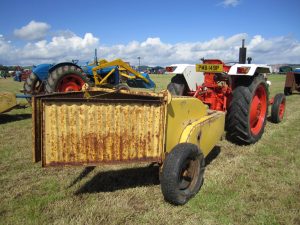 external air; therefore it becomes necessary, not merely to turn this kind of hay from time to time, but to ted it very minutely, spreading it like a blanket, as evenly as possible, over the whole surface of the ground, o that no part of it may be much excluded from the influence of the drying winds, ore rays of the sun. In this way, when the weather is good, natural hay may be made, in eh course of a week, ready to be put into cocks of 20 or 25 stone weight, where it ought to remain, well tied down, and neatly dressed in the sides and at the bottom, for eight days more; when it may safely be collected into larger ricks, and finally into sows of greater dimension. In wet weather, this process is no doubt protracted to a longer period, but still it will be found, that to spread it as thinly over the field as the ground will admit of, will be the surest way to preserve it from material injury; for although, in this case, it is exposed to every shower that falls, yet as it is not any where of much thickness, the water is not retained, but sinks through it, to the ground; and on the return of the first breeze, in a few hours the upper parts will be dry, and if then turned, the under side, in like manner, will receive the same benefit.
external air; therefore it becomes necessary, not merely to turn this kind of hay from time to time, but to ted it very minutely, spreading it like a blanket, as evenly as possible, over the whole surface of the ground, o that no part of it may be much excluded from the influence of the drying winds, ore rays of the sun. In this way, when the weather is good, natural hay may be made, in eh course of a week, ready to be put into cocks of 20 or 25 stone weight, where it ought to remain, well tied down, and neatly dressed in the sides and at the bottom, for eight days more; when it may safely be collected into larger ricks, and finally into sows of greater dimension. In wet weather, this process is no doubt protracted to a longer period, but still it will be found, that to spread it as thinly over the field as the ground will admit of, will be the surest way to preserve it from material injury; for although, in this case, it is exposed to every shower that falls, yet as it is not any where of much thickness, the water is not retained, but sinks through it, to the ground; and on the return of the first breeze, in a few hours the upper parts will be dry, and if then turned, the under side, in like manner, will receive the same benefit.
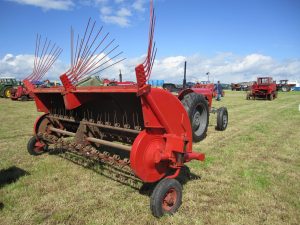 A much more complex mode of hay making was formerly in use in this county, but is now pretty generally exploded, on account of the objections to which it is liable. This consisted (with hay of all descripptions) in spreading it out immediately after the scythe, in the fore part of the day, and putting it into cocks before night, which were increased in size from day to day, in proportion as the hay had advanced in making, till in the the end it became fit for the sow, or larger stack. On fair weather, there can be no question, that with this perpetual bustle, which was mistaken for exertion, the hay might be made in not much longer time, though with much greater expense, and perhaps be little inferior in quality, than it can be in the simple mode first mentioned. Yet, in wet weather, the point most to be guarded against, in every one circumstance above stated, it was miserly defective. The hay from the repeated teasing it was subjected to, was not only deprived of its natural juices and flavour, but from the soft bruised state to which it was reduced, it became quite unfit to repel moisture, but, on the contrary, imbibed it like a sponge, It is indeed true, that hay in cock receives less of the rain that falls, than hay that is spread over the whole surface of the ground; yet it is equally true, that hardly a single drop which falls on such hay as this is exhaled naturally, neither can it penetrate through it to the ground; but in the worst manner that can happen, it sinks down into the heart of the heap, where it occasions fermentation and rottenness, unless speedily relieved, by being again shaken out, in whatever state the weather may be.
A much more complex mode of hay making was formerly in use in this county, but is now pretty generally exploded, on account of the objections to which it is liable. This consisted (with hay of all descripptions) in spreading it out immediately after the scythe, in the fore part of the day, and putting it into cocks before night, which were increased in size from day to day, in proportion as the hay had advanced in making, till in the the end it became fit for the sow, or larger stack. On fair weather, there can be no question, that with this perpetual bustle, which was mistaken for exertion, the hay might be made in not much longer time, though with much greater expense, and perhaps be little inferior in quality, than it can be in the simple mode first mentioned. Yet, in wet weather, the point most to be guarded against, in every one circumstance above stated, it was miserly defective. The hay from the repeated teasing it was subjected to, was not only deprived of its natural juices and flavour, but from the soft bruised state to which it was reduced, it became quite unfit to repel moisture, but, on the contrary, imbibed it like a sponge, It is indeed true, that hay in cock receives less of the rain that falls, than hay that is spread over the whole surface of the ground; yet it is equally true, that hardly a single drop which falls on such hay as this is exhaled naturally, neither can it penetrate through it to the ground; but in the worst manner that can happen, it sinks down into the heart of the heap, where it occasions fermentation and rottenness, unless speedily relieved, by being again shaken out, in whatever state the weather may be.
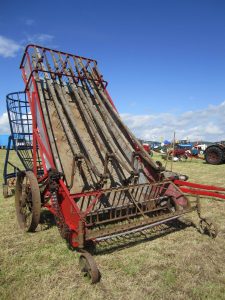 Indeed to this alternative are hay makers, on this system, frequently reduced, more particularly, if in their endeavours to guard against a shower, and taken at unawares, they have re-cocked their hay after the rain has begun to fall; a mistake, from their ill-grounded apprehensions of danger from exposure, they are very ready to commit. In fact, this whole system, from beginning to end, is, of all others, the most tedious, the most expensive, and the most hazardous; superfluous labour at the best, in fair weather, and injurious in no small degree of times of rain, which in many hay-making seasons is but too prevalent in this country.
Indeed to this alternative are hay makers, on this system, frequently reduced, more particularly, if in their endeavours to guard against a shower, and taken at unawares, they have re-cocked their hay after the rain has begun to fall; a mistake, from their ill-grounded apprehensions of danger from exposure, they are very ready to commit. In fact, this whole system, from beginning to end, is, of all others, the most tedious, the most expensive, and the most hazardous; superfluous labour at the best, in fair weather, and injurious in no small degree of times of rain, which in many hay-making seasons is but too prevalent in this country.
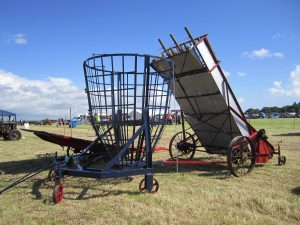 Hay is seldom hurt here by heating; and as to its taking fire, from that circumstance, it is unknown in this county. The only instance that I have heard of in the neighbourhood, happened at a Distillery, in an adjourning county, near the border of this, where a sow of hay, of 20,000 stone weight, (about 200 tons) was conjectured to be in the way of taking fire; upon which, all hands were ordered to take it down and spread it out, when some of it, as it was carrying away, was actulaly seen to burst into flame! a circumstance, that many people here will not credit, to very little were were accustomed to such an accountable fact. Several such accounts have, however, been stated in newspapers as happening in England; where, if it is the practice to make their hay in the manner last mentioned, (as seems to be in some counties the case), the one circumstance will account for the other, as hardly a plan of hay-making could be derived more ready than it to engender such a phenomenon.”
Hay is seldom hurt here by heating; and as to its taking fire, from that circumstance, it is unknown in this county. The only instance that I have heard of in the neighbourhood, happened at a Distillery, in an adjourning county, near the border of this, where a sow of hay, of 20,000 stone weight, (about 200 tons) was conjectured to be in the way of taking fire; upon which, all hands were ordered to take it down and spread it out, when some of it, as it was carrying away, was actulaly seen to burst into flame! a circumstance, that many people here will not credit, to very little were were accustomed to such an accountable fact. Several such accounts have, however, been stated in newspapers as happening in England; where, if it is the practice to make their hay in the manner last mentioned, (as seems to be in some counties the case), the one circumstance will account for the other, as hardly a plan of hay-making could be derived more ready than it to engender such a phenomenon.”
The photographs were taken at the Fife Vintage Agricultural Machinery Rally, June 2014.
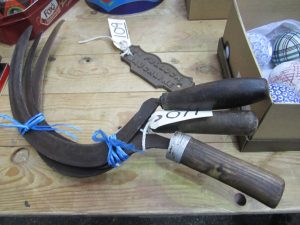 “In reaping, the sickle is universally made use of. An evident improvement of the sickle is now very generally introduced. The old sickle, which is still most frequently used, is teethed somewhat like a saw; the teeth soon wear out, and, for the most part, the sickle is henceforth useless, unless the teeth be renewed on the anvil. The improved sickle is broader on the blade; it has no teeth, and is of a better metal; on the principle of the scythe, it is sharpened from time to time by a stone. It cuts with more ease than the other, and lasts for a much longer time.
“In reaping, the sickle is universally made use of. An evident improvement of the sickle is now very generally introduced. The old sickle, which is still most frequently used, is teethed somewhat like a saw; the teeth soon wear out, and, for the most part, the sickle is henceforth useless, unless the teeth be renewed on the anvil. The improved sickle is broader on the blade; it has no teeth, and is of a better metal; on the principle of the scythe, it is sharpened from time to time by a stone. It cuts with more ease than the other, and lasts for a much longer time.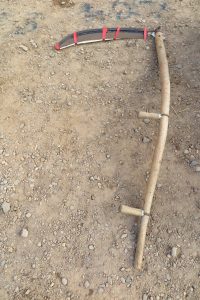 By the sickle the grain is, no doubt, cut down more regularly, and is more easily collected into sheaves than by any other method, but the operation is slow, and it requires many hands. it would be perhaps the most important acquisition to agricultural operations that has been made for a long while, if an instrument were invented, by which corns could be cut down, and the sametime gathered into sheaves, as hay is cut down by the scythe. In grounds completely level and free from stones , like the Cras of Stirlingshire, an estimate might at least be made in the proportional expense, whether by labour or by loss, or reaping corns with the sickle or with the scythe.
By the sickle the grain is, no doubt, cut down more regularly, and is more easily collected into sheaves than by any other method, but the operation is slow, and it requires many hands. it would be perhaps the most important acquisition to agricultural operations that has been made for a long while, if an instrument were invented, by which corns could be cut down, and the sametime gathered into sheaves, as hay is cut down by the scythe. In grounds completely level and free from stones , like the Cras of Stirlingshire, an estimate might at least be made in the proportional expense, whether by labour or by loss, or reaping corns with the sickle or with the scythe.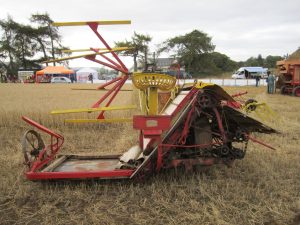 In placing the stock, attention is paid in this climate, as ought perhaps to be done in every other, throughout the kingdom, to the point of the compass from which the storm or weather most generally blows. If the side of the stock be placed towards the point, the greatest possibe surface is exposed to the weather, and the corn suffers accordingly; the end of the stock therefore is presented to the weather. In this district, from the circumstances of the weather, the stock is generally placed in a direction from S.W. to N.E. In narrow allies, and where hills and woods interfere, there may arise a difference of the currents of air, and in such situations experience must guide.
In placing the stock, attention is paid in this climate, as ought perhaps to be done in every other, throughout the kingdom, to the point of the compass from which the storm or weather most generally blows. If the side of the stock be placed towards the point, the greatest possibe surface is exposed to the weather, and the corn suffers accordingly; the end of the stock therefore is presented to the weather. In this district, from the circumstances of the weather, the stock is generally placed in a direction from S.W. to N.E. In narrow allies, and where hills and woods interfere, there may arise a difference of the currents of air, and in such situations experience must guide.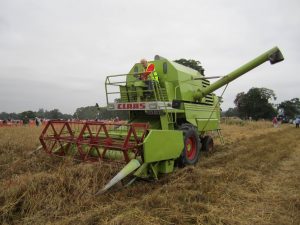 When the sheaves are exhausted of the moisture which had remained in the stalks, or which they had imbibed from the weather, they are built up into large ricks or stacks, of a circular form, and with conical form, and with conical tops, the eaves, at the commencement of the top, projecting over the body of the stack to ward off the rain. The conical top is thatched with straw. These stacks contain from 30 to 90 or 100 thrives of victual, a thrave being two stocks. No great quantity of grain is put ito the barn at once; it is safer in the stack from the depredations of vermin.
When the sheaves are exhausted of the moisture which had remained in the stalks, or which they had imbibed from the weather, they are built up into large ricks or stacks, of a circular form, and with conical form, and with conical tops, the eaves, at the commencement of the top, projecting over the body of the stack to ward off the rain. The conical top is thatched with straw. These stacks contain from 30 to 90 or 100 thrives of victual, a thrave being two stocks. No great quantity of grain is put ito the barn at once; it is safer in the stack from the depredations of vermin.



